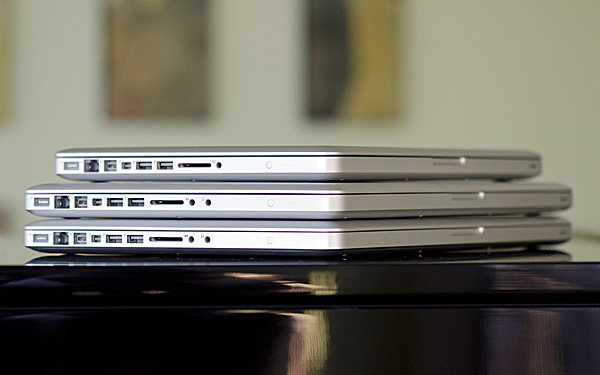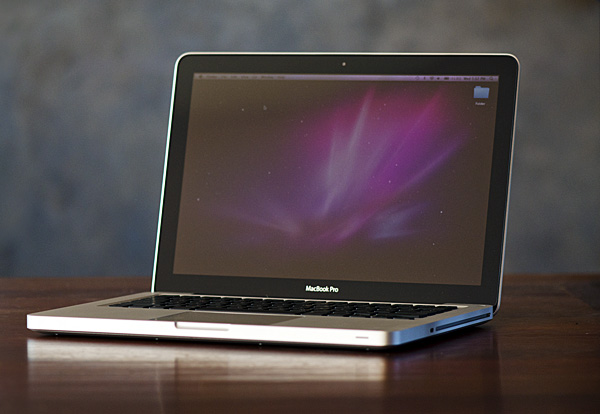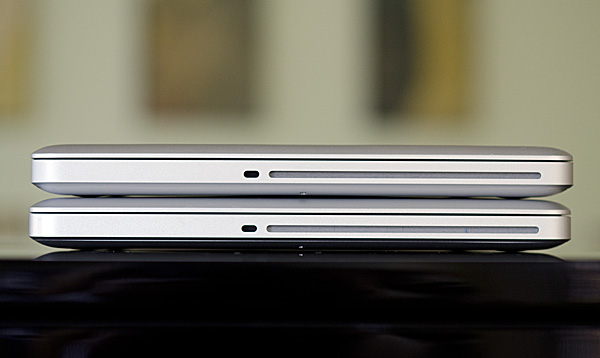The MacBook Pro Review (13 & 15-inch): 2011 Brings Sandy Bridge
by Anand Lal Shimpi, Brian Klug & Vivek Gowri on March 10, 2011 4:17 PM EST- Posted in
- Laptops
- Mac
- Apple
- Intel
- MacBook Pro
- Sandy Bridge
Last year at the iPad introduction Steve Jobs announced that Apple is a mobile device company. Just last week Steve returned to introduce the iPad 2 and point out that the majority of Apple's revenue now comes from products that run iOS. The breakdown is as follows:
| AAPL Revenue Sources—Q1 2011 | |||||||||
| iPad | iPhone | iPod | Mac | iTunes Store | Software/Services | Peripherals | |||
| Percentage | 17.2% | 39.1% | 12.8% | 20.3% | 5.4% | 2.9% | 2.2% | ||
Just looking at iPad and iPhone, that's 56% of Apple's sales. All Macs put together? Only 20%. Granted 20% of $26.7 billion in sales is still $5.3 billion, but the iOS crew gets most of the attention these days.
It shouldn't come as a surprise that when Apple launched its 2011 MacBook Pro lineup last week that it did so with little fanfare. There was no special press event and no video of an unusually charismatic man on a white background describing the latest features of the systems. All we got two weeks ago were a few pages describing the high level features of the lineup, a short outage on the Mac Store and five new configurations available for sale.

Apple tends to not mix architecture updates and chassis changes. The 2011 MacBook Pro lineup is no different. These models fundamentally implement the same updated unibody shell that was introduced in 2009. The term unibody comes from the fact that the base of the chassis is machined out of a single block of aluminum. There's no way to gain access to the MacBook Pro's internals from above, you have to go in from below. As a result there's absolutely no chassis flex or squeaking while you pound on the keyboard, use the trackpad or just interact with the part of the machine that you're most likely to be touching. Apple has been shipping unibody MacBook Pros since 2008 and from my experience the design has held up pretty well.

From top to bottom: 13-inch MBP (2011), 15-inch MBP (2011), 15-inch MBP (2010)
The biggest letdown in the design has been the hinge connecting the display to the rest of the chassis. I haven't had it fail completely but I've had it become frustratingly loose. Even brand new, out of the box, the 15-inch MacBook Pro will have its display move by a not insignificant amount if you tilt the machine 90 degrees so that the display is parallel to the ground. A number of readers have written me over the years asking if Apple has improved the locking ability of the hinge in each new version of the MacBook Pro. It doesn't seem to be any better with the 2011 model—sorry guys.
Other than screen size, ports and internals, there's nothing that separates the 13-, 15- and 17-inch MacBook Pros from one another. They all feature the same excellent backlit keyboard (keyboard size is constant across all models) and a variant of the same high quality display. All of them have the same front facing 720p camera and the same large glass-covered trackpad.
Battery capacity hasn't changed compared to last year, although power consumption on some models has gone up (more on this later).
| 2011 MacBook Pro Lineup | |||||||
| 13-inch (low end) | 13-inch (high end) | 15-inch (low end) | 15-inch (high end) | 17-inch | |||
| Dimensions |
0.95 H x 12.78 W x 8.94 D
|
0.95 H x 14.35 W x 9.82 D
|
0.98 H x 15.47 W x 10.51 D
|
||||
| Weight |
4.5 lbs (2.04 kg)
|
5.6 lbs (2.54 kg)
|
6.6 lbs (2.99 kg)
|
||||
| CPU |
2.3 GHz dual-core Core i5
|
2.7 GHz dual-core Core i7
|
2.0 GHz quad-core Core i7
|
2.2 GHz quad-core Core i7
|
2.2 GHz quad-core Core i7
|
||
| GPU |
Intel HD 3000 Graphics
|
Intel HD 3000 + AMD Radeon HD 6490M (256MB)
|
Intel HD 3000 + AMD Radeon HD 6750M (1GB)
|
Intel HD 3000 + AMD Radeon HD 6750M (1GB)
|
|||
| RAM |
4GB 1333MHz DDR3 (8GB max)
|
||||||
| HDD |
320GB 5400 RPM
|
500GB 5400 RPM
|
500GB 5400 RPM
|
750GB 5400 RPM
|
750GB 5400 RPM
|
||
| Display Resolution |
1280x800
|
1440x900 (1680x1050 optional)
|
1920x1200
|
||||
| Ports |
Gigabit LAN, Firewire 800, Thunderbolt, 2x USB 2.0, SDHC slot, combined audio in/out jack
|
Gigabit LAN, Firewire 800, Thunderbolt, 2x USB 2.0, SDHC slot, separate audio in/out jacks
|
Gigabit LAN, Firewire 800, Thunderbolt, 3x USB 2.0, separate audio in/out jacks, ExpressCard 34 slot
|
||||
| Battery Capacity |
63.5Wh
|
77.5Wh
|
95Wh
|
||||
| Price | $1,199 | $1,499 | $1,799 | $2,199 | $2,499 | ||
The new MacBook Pros are still equipped with DVD drives and thus Apple still distributes OS X and the application preload on a pair of DVDs. I was hoping Apple would go to an all-USB distribution starting with the MBA but it looks like we'll have to wait for another generation of Pro systems before we see that.












198 Comments
View All Comments
jb510 - Friday, March 11, 2011 - link
It would seem to me their is one currently shipping Thunderbolt periphral... A 2011 MBP in target disk mode. Maybe you could drop an SSD in one and do some preliminary testing?jb510 - Friday, March 11, 2011 - link
damn... wish i could edit that comment originally typed on my iphone... but their doesn't appear to be any way... (misspelling repeated for comedic effect)deadshort - Friday, March 11, 2011 - link
Thanks for the genuinely informative review. Running both low-load and high-load battery tests is especially helpful to developers, etc.One question. You chose the 2.3Ghz/8MB cache system. Was that just 'cuz you swing that way, or do you expect significant performance benefits for some workload you care about? For these machines is it a 10% price goldplate, or a reasonable increment to keep these CPUs fed? I am seriously interested....
Brian Klug - Friday, March 11, 2011 - link
I can speak for myself at least, but part of the reason for the 2.3/8 MB system choice was that it's the only preconfigured (Apple Store available) configuration that comes with the anti-glare display.Essentially, if you're a customer walking into the apple store and don't want the glossy/glare display, you're immediately forced into buying the highest-specced (and most expensive) MacBook Pro. It's frustrating because the only way to get lower specced systems is BTO online.
Obviously we got these systems on launch date to immediately start working, and that was the reason for the 2.3 choice.
-Brian
synaesthetic - Friday, March 11, 2011 - link
You know, I don't get this thin crap. I really don't.I mean, I can understand it. From a purely aesthetic point of view. Sort of, anyway.
I'm sick of "thin" gadgets with weak performance and fragile builds. Thick gadgets means more tech fits inside. My HTC Glacier is quite thin, and you know what? I wish it was thicker. It'd be easier to hold onto, and HTC could have put a bigger battery in it!
Stop making things so stupidly thin. Instead of driving the miniaturization of components on "thin," why not take that same miniaturization power and make things a bit thicker... with more power/cooling/battery inside?
Thin may be sexy, but powerful is even sexier!
Then again, Apple's never really cared to broadcast the specs of their devices, hoping instead to gloss over it to such a degree that nobody questions paying ridiculously inflated prices...
Marc B - Friday, March 11, 2011 - link
I am finally buying my first MacBook this year, and I am 70/30 leaning toward the 15" MBP. The 17" version has the high res screen and express port, but the 15" MBP is lighter/smaller and has the SDXC reader. Will the Thunderbolt port will provide enough throughput to allow simultaneous in/out?I am using this to log HD video on location, and was wondering if the express port is no longer necessary to use with a small ESATA array now that you can have high speed storage in and out using the Thunderbolt port.
Belard - Friday, March 11, 2011 - link
If Apple is pushing their notebooks to be more and more Desktop replacements...Where is a docking bay to handle all the connectors? How hard for a single connector to handle everything?
Lenovo sells about 3 different Docking units $130~300 for their regular Thinkpad line (ie: NOT Edge or L/SL series).
We have a few users who use them. Comes to the office, drop the notebook into the dock and turn it on, not a single cable to be attached. They include 4 USB ports (or more), PS/2 ports, HDMI and DVI ports, Ethernet and of course charge up the battery.
So one user would have to plug in 7 cables everyday if he didn't have a dock... like his keyboard, wireless desktop mouse, 21" display, various printers and devices, etc.
name99 - Friday, March 11, 2011 - link
" I still haven't figured out how to actually grab SINR out on here, all I can see for the moment is just RSSI. "Apple's Airport Utility does give you part of what you want.
If you open it, go to "Manual Setup", see the summary page, and click on where it says "Wireless Clients: 2" (or 3 or whatever) you will be given a page that, for each connection, shows their signal and noise levels (along with a graph).
Of course this doesn't exactly have any bearing on what we are discussing, because the numbers that are presented are the intermediate term SINR values, relevant to shadowing but not to fading. The numbers that are relevant to fading (and thus to MIMO tricks) change on a millisecond time scale, and so what one really wants is an indication of their standard deviation, along with other info like the connection diversity. This is all way more geeky than Apple (or any other consumer company) is going to provide.
humunculus - Friday, March 11, 2011 - link
Any chance you could run a few of the tests on the 2.0 and 2.2 GHz models. I am interested in how much performance difference there is between the 2.2 and 2.3 GHz 15 inch Macbook Pro models. It is hard to assess if the 10% cost increase is warranted. ThanksBelard - Saturday, March 12, 2011 - link
The $400 price difference is for the extra 200mhz (Apple values that at $250 - these are notebook CPUs, so pricing from intel is a factor)And then $150 to sometimes double the performance of the GPU for games.
Oh, and an extra 250GB of HD space (which is about $5 in the real world).